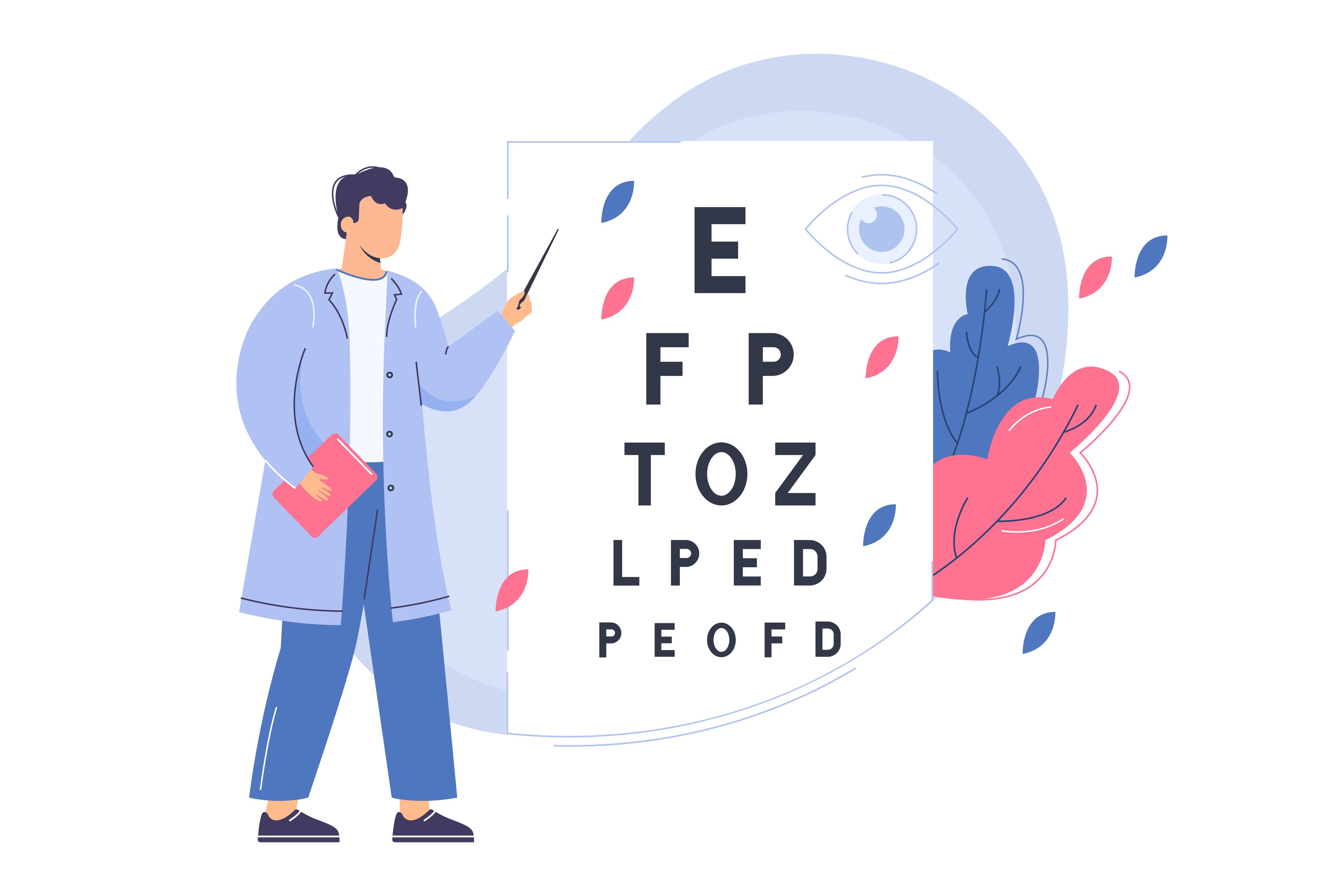- Bone Health
- Immunology
- Hematology
- Respiratory
- Dermatology
- Diabetes
- Gastroenterology
- Neurology
- Oncology
- Ophthalmology
- Rare Disease
- Rheumatology
SB15 Effective, Safe in Treating nAMD Before, After Switching
A study found SB15, an aflibercept biosimilar, is just as effective as its reference drug Eylea, the current standard treatment for neovascular age-related macular degeneration (nAMD), a condition that causes vision loss.
Ophthalmologist with eye test | Image Credit: redgreystock - stock.adobe.com

A multi-region study found comparable efficacy, safety, immunogenicity, and pharmacokinetics (PK) in SB15 vs reference aflibercept (AFL; Eylea), both as a first-line therapy and after switching from AFL to SB15 in neovascular age-related macular degeneration (nAMD).
A phase 3, prospective, double-masked, randomized trial had to include treatment-naïve subfoveal choroidal neovascularization (CNV) with AMD occupying at least 50% of the total lesion, a total lesion area of 9 or more disc areas (DA; including blood, scars, and neovascularization).
The main study period followed patients for up to 32 weeks. Patients were randomized to receive either 2 mg intravitreal injections of SB15 or AFL every 4 weeks for the first 3 injections followed by dosing once every 8 weeks up to week 48. At week 32, patients on the originator were re-randomized to switch to SB15 or maintain prior treatment (AFL/SB15 group; AFL/AFL group).
Efficacy was determined using optical coherence tomography combined with Early Treatment Diabetic Retinopathy Study charts based on retinal images found by a central reading center. Overall quality of life was measured using the National Eye Institute 25 Item Visual Function Questionnaire. Secondary efficacy endpoints were found in the changes in baseline best-corrected visual acuity (BCVA) score, up to week 56 along with proportions of participants losing less than 15 letters or gaining 15 or more letters.
Results included 56 study centers across Europe, US, Russia, the Republic of Korea, and Japan with a total of 425 participants completing 56 weeks of data from June 2020 to February 2021. Demographics from baseline to week 32 included similar ages across each group, majority of the cohort being female, White, and from European regions.
The BCVA total letter scores were similar values before and after switching (SB15, n = 10.6; AFL, n = 1.19, AFL/SB15, n = 11.37; AFL/AFL, n = 11.12). There were no significant differences in central subfield thickness (CST) from baseline to week 32 (SB15, 95.61 µm; AFL, 121.96 µm; AFL/SB15, 126.24 µm; AFL/AFL, 119.81 µm) nor did the total retinal thickness (TRT) in the SB15 and AFL groups before the switch (140.06 mm2, 145.44 mm2, respectively) or afterwards (AFL/SB15; 166.17 mm2, AFL/AFL; 121.81 mm2, respectively).
Patients with nAMD had almost no changes in choroidal neovascularization (CNV) area before or after switching (SB15, 4.34%; AFL, 4.76%; AFL/SB15, 4.59%; AFL/AFL, 4.86%). The subtle data changes acknowledge the comparable efficacy between SB15 and AFL.
At week 32, about 97.6% of participants from baseline continued treatment after switching but 94.7% completed the entire 56-week trial.
Regarding BCVA, the treatment groups had similar least mean square (LSmean) results (SB15/SB15, 7.4 letters; AFL/AFL, 7 letters; AFL/SB15, 7.9 letters). No notable changes in CST during the study period were observed (SB15, 119.2 µm; AFL/AFL, 126.6 µm; AFL/SB15, 136.4 µm). There were no significant changes in TRT from baseline to week 56 (SB15/SB15, 132.4 µm; AFL/AFL,136.3µm; AFL/SB15, 151.1 µm). The changes in CNV size before and after the treatment switches were not significantly different (SB15/SB15, 1.26 mm2; AFL/AFL, 1.09 mm2; AFL/SB15, 0.68 mm2).
Most treatment-emergent adverse events (TEAEs) were mild or moderate, usually unrelated to the study drug or injection procedure, ensuring treatment safety. Each group had the presence of TEAEs in comparable amounts (SB15/SB15, 36.50%; AFL/SB15, 35.10%; AFL/AFL, 29.80%). The rates of non-ocular TEAEs were comparable between the groups (SB15/SB15, 25.10%; AFL/SB15, 22.50%; AFL/AFL, 23.10%). Ocular TEAEs by preferred term in the study eye had more patients experiencing cataracts and visual acuity reduction in the SB15 and AFL continuation groups while the AFL/SB15 group had higher percentages of posterior capsule opacification and xerophthalmia.
The study showed comparable treatment-induced and treatment-boosted antidrug antibodies (ADAs) between all groups. Following week 32, 1% of the AFL/AFL group developed treatment-induced ADAs but the SB15/SB15 and AFL/SB15 did not.
Prior to week 32, serum concentrations were similar in PK between SB15 and AFL groups. After switching, all treatment groups were below the limit of quantification, measuring Ctrough predose at weeks 40 and 56 (BLQ; 5 ng/mL).
Limitations of the study are the small sample sizes of the AFL/SB15 and AFL/AFL treatment groups in comparison with the SB15/SB15 groups. The study should be reviewed cautiously at week 56 because it was not meant to assess equivalence between treatment groups.
The biosimilarity of SB15 maintained comparable efficacy, safety, immunogenicity, and PK to AFL throughout 56 weeks in patients with nAMD. Overall, the study supports switching patients from AFL to SB15 treatment.
Reference
Woo SJ, Sadda SR, Bradvica M, et al. Biosimilar SB15 versus reference aflibercept in neovascular age-related macular degeneration: 1-year and switching results of a phase 3 clinical trial. BMJ Open Ophthalmol. Published online December 29, 2023. doi:10.1136/bmjophth-2023-001561
Newsletter
Where clinical, regulatory, and economic perspectives converge—sign up for Center for Biosimilars® emails to get expert insights on emerging treatment paradigms, biosimilar policy, and real-world outcomes that shape patient care.
